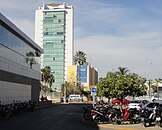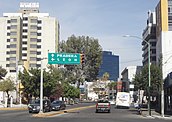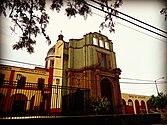Irapuato | |
|---|---|
Clockwise from upper left: Templo del Hospitalito, Centro Histórico, Zona Dorada , Museo de la Ciudad, Templo de Santiaguito and Catedral de Nuestra Señora de la Soledad. | |
|
| |
| Nickname(s): | |
| Motto(s): | |
| Coordinates: 20°40′N 101°21′W / 20.667°N 101.350°W | |
| Country | |
| State | |
| Municipality | |
| Founded | February 15, 1547 |
| Founded as | Congregación de San Marcos Irapuato |
| Founded by | Vasco de Quiroga[1] |
| Government | |
| • Municipal President | Lorena del Carmen Alfaro García |
| Area | |
| • City | 69.68 km2 (26.90 sq mi) |
| • Municipality | 851 km2 (329 sq mi) |
| Elevation | 1,724 m (5 676 ft) |
| Population (2020 census)[2] | |
| • City | 452,090 |
| • Density | 6,500/km2 (17,000/sq mi) |
| • Municipality | 592,953 |
| • Municipality density | 700/km2 (1,800/sq mi) |
| Demonym(s) | Irapuatense, Fresero |
| Time zone | UTC-6 (Central Standard Time) |
| • Summer (DST) | UTC-5 (Central Daylight Time) |
| ZIP code | 36590 - 36899 |
| Area code | 462 |
| Website | Official Website of the City of Irapuato |
| Average temperature 19°C | |
Irapuato is a Mexican city and municipality located at the foot of the Arandas Hill (in Spanish: Cerro de Arandas), in the central region of the state of Guanajuato. It lies between the Silao River and the Guanajuato River, a tributary of the Lerma River, at 1,724 m (5,656 ft) above sea level. It is located at 20°40′N 101°21′W / 20.667°N 101.350°W. The city is the second-largest in the state (only behind León), with a population of 342,561 according to the 2005 census, while its municipality has a population of 529,440.[3] The municipality has an area of 851 km2 (329 sq mi) and includes numerous smaller outlying communities. Although it is now an important center for regional trade and transportation center as well the site of several automotive and chemical manufacturing plants, the city's main industry has historically been agriculture and it has long been known for its strawberries and industry of refried beans, also the raising of pigs and cattle. The fruits and flowers of Irapuato's luxurious gardens are well known throughout Mexico.
- ^ "Historia de Irapuato". Enciclopedia de los Municipios de México. Archived from the original on 2012-03-20. Retrieved 2007-03-22.
- ^ Citypopulation.de Population of Irapuato municipality with localities
- ^ "2005 Census". INEGI: Instituto Nacional de Estadística, Geografía e Informática. Archived from the original on 2007-03-28. Retrieved 2007-03-22.









